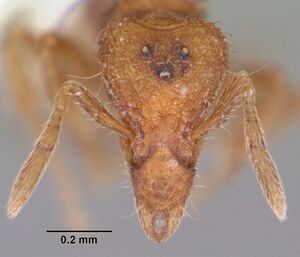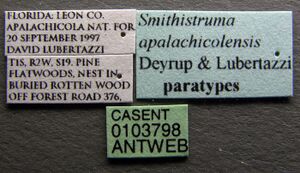Strumigenys apalachicolensis
| Strumigenys apalachicolensis | |
|---|---|

| |
| Scientific classification | |
| Kingdom: | Animalia |
| Phylum: | Arthropoda |
| Class: | Insecta |
| Order: | Hymenoptera |
| Family: | Formicidae |
| Subfamily: | Myrmicinae |
| Tribe: | Attini |
| Genus: | Strumigenys |
| Species: | S. apalachicolensis |
| Binomial name | |
| Strumigenys apalachicolensis (Deyrup & Lubertazzi, 2001) | |
Specimens of this species were found in poorly drained, fire-maintained flatwoods with an open canopy of large pines and dense herbaceous ground cover in the Apalachicola National Forest of Florida. Two specimens were found in pitfall traps, and an intensive search of the area around these pitfall traps yielded a nest with 332 individuals.
Identification
Distinguished from all other Nearctic Strumigenys by the following combination of character states: head with preocular laminae convergent distally, so head in frontal view roughly cuneiform; mandibles with a conspicuous diastema between the triangular basal tooth and the subapical series of teeth; marginal and discal hairs of clypeus sparse, long, filiform, slightly recurved.
Similar species. In Brown's 1953 key to the North American species of Smithistruma north of Mexico, P. apalachicolensis specimens cannot be readily taken past couplet past couplet 10, which separates species with a wedgeshaped head and no conspicuous mandibular diastema from species that do not have a wedge-shaped head and do have a conspicuous mandibular diastema. Strumigenys apalachicolensis, and another recently described species, S. archboldi (Deyrup and Cover) (1998), have both the wedge-shaped head and the conspicuous mandibular diastema. The clypeal pilosity of S. archboldi is not suberect and fill form, but proclinate and narrowly spatulate. If one were to de-emphasize the shape of the head, S. apalachicolensis would easily key to S. filitalpa (Brown) in Brown's treatment; while the two species are similar, the clypeal pilosity is different (Fig. 3), and the mandibular dentition is also different, according to the description of the mandibles of S. filitalpa (Brown 1953). If one were to ignore the mandibular diastema, S. apalachicolensis would key to S. laevinasis (M. R. Smith), but the latter species has much denser clypeal pilosity, with the hairs not suberect. (Fig. 4). As indicated by these disparities between S. apalachicolensis and other species, this new species does not fit into the provisional species groups in Brown's 1953 work, falling somewhere between the clypeata group and the talpa group.
Keys including this Species
Distribution
Latitudinal Distribution Pattern
Latitudinal Range: 30.46° to 30.38333333°.
| North Temperate |
North Subtropical |
Tropical | South Subtropical |
South Temperate |
- Source: AntMaps
Distribution based on Regional Taxon Lists
Nearctic Region: United States (type locality).
Distribution based on AntMaps
Distribution based on AntWeb specimens
Check data from AntWeb
Countries Occupied
| Number of countries occupied by this species based on AntWiki Regional Taxon Lists. In general, fewer countries occupied indicates a narrower range, while more countries indicates a more widespread species. |

|
Estimated Abundance
| Relative abundance based on number of AntMaps records per species (this species within the purple bar). Fewer records (to the left) indicates a less abundant/encountered species while more records (to the right) indicates more abundant/encountered species. |

|
Biology
Deyrup and Lubertazzi (2001) - The large nest series and two collections of stray specimens were in open, low pine flatwoods (for a discussion of Florida pine flatwoods, see Myers and Ewel 1990). The open, sparsely forested character of this habitat is maintained by frequent fires (about every 4-15 years). Before European settlement of Florida, fires were probably caused by summer thunderstorms, but the fragmentation of the landscape now requires fire management by national forest personnel to prevent the development of unnaturally dense hardwood forest and thickets over much of the flatwoods habitat. The fires remove much of the standing vegetation, except pines, and most of the ground litter. The water table is high, and in the summer rainy season the soil may become flooded or saturated for a few days or weeks. In such habitats we usually find dacetine ants, including Strumigenys louisianae Roger and several other species, confined to patches that escape burning along the edges of streams or swamps, or more rarely in large grass tussocks or in the thick layers of bark at the bases of large pines.
The nest was in an area with scattered Pinus palustris, shrubs (Ilex glabra (L.) Gray, Quercus minima (Sarg.) Small, Serenoa repens (Bartr.) Small, Lyonia fruticosa (Mich.) G. S. Torr.), and herbaceous plants (Aristida beyrichiana Trin. & Rupr., Pteridium aquilinum (L.) Kuhn, Balduina uniflora Nutt., Seymeria cassioides (G. F. Gmel.) S. F. Blake, Sabatia brevifolia Raf., Aster torttfolius L.). The soil type was Leon sand.
With over 300 individuals, the nest is the most populous Strumigenys nest the authors have seen in Florida. It is tempting to relate this to some habitat feature, such as a scarcity of suitable nest sites or a lack of competition from other dacetines, but it is possible that this nest was abnormally large for the species; only additional field research could clarify this.
Castes
Worker
Images from AntWeb
  
| |
| Paratype of Strumigenys apalachicolensis. Worker. Specimen code casent0103886. Photographer April Nobile, uploaded by California Academy of Sciences. | Owned by ABS, Lake Placid, FL, USA. |
Queen
Images from AntWeb
   
| |
| Paratype of Strumigenys apalachicolensis. Queen (alate/dealate). Specimen code casent0103798. Photographer April Nobile, uploaded by California Academy of Sciences. | Owned by ABS, Lake Placid, FL, USA. |
Nomenclature
The following information is derived from Barry Bolton's Online Catalogue of the Ants of the World.
- apalachicolensis. Pyramica apalachicolensis Deyrup & Lubertazzi, 2001: 15, figs. 1-3 (w.) U.S.A. Combination in Strumigenys: Baroni Urbani & De Andrade, 2007: 115
Description
Worker
Holotype worker, Measurements in mm: total length: 2.11; head length: 0.65: maximum head width: 0.33; length of mesosoma: 0.53. Features described below as in Fig. 1. Head in frontal view with preocular laminae convergent distally and clypeus narrow, so head in frontal view roughly cuneiform. Mandibular diastema conspicuous at full closure; mandibular apices strongly decurved in lateral view; mandible (as in Fig. 2) with a triangular basal tooth, two large subequal subapical teeth, followed by two teeth about one half the length of the first pair, followed by an indistinct series of vestigial teeth. Clypeus about as long as wide, finely reticulate, with sparse erect, somewhat recurved filiform hairs in marginal, submarginal, antesubmarginal series, each hair rising from a small tubercle. Antennal scapes with proclinate, curved, unmodified hairs. Frontal and occipital areas with suberect curved hairs that appear in lateral view similar in length and type to those on the clypeus; a pair of long, irregularly curved, filiform hairs on the edge of the antennal scrobe above the eyes, on the sides of the occipital lobes, and on the tops of the occipital lobes. Head and body without any spatulate or spoon-shaped hairs, though the larger, proclinate, curved hairs on the femora and tibiae are slightly flattened, so that they shine under illumination. Pronotum reticulate, with two pairs of long, irregularly curved, filiform hairs on a pair of weak carinae along the lateral margins of the pronotal disc; remainder of mesosoma reticulate dorsally, shining along sides. Propodeal teeth short, triangular; infradental laminae conspicuously emarginate above. Mid and hind tibiae and basitarsi with a long, irregularly curved, filiform hair at proximal third of length. Petiole and postpetiole finely reticulate; infrapetiolar lamina gradually emarginate medially; lower postpetiolar spongiform process large, extending length of basal face of first sternite of gaster; gaster shining, with sparse, long, irregularly curved, filiform, erect hairs.
Queen
Total length: 2.43; head length: 0.67; maximum head width: 0.40; length of mesosoma: 0.62; length of forewing: 2.12.
Type Material
All type material is from the same site: FLORIDA: Leon County, Apalachicola National Forest, off Forest Service Road 373, TIS, R2W, S19; pine flatwoods habitat, stand of Pinus palustris Mill. All specimens collected by D. Lubertazzi. Two specimens collected in pitfall traps, 21 July 1997; remaining specimens collected from nest in soil, 20 September 1997. Paratypes. Paratype material is 213 workers and 27 alate females.
Holotype, 36 paratypes: Museum of Comparative Zoology, Harvard University, Cambridge, Mass.; 20 paratypes: National Museum of Natural History, Smithsonian Institution, Washington, D.C.; 20 paratypes: The Natural History Museum, London; 20 paratypes: Los Angeles County Museum of Natural History; 12 paratypes: Florida State Collection of Arthropods, Gainesville, Florida; 20 paratypes: arthropod collection, Archbold Biological Station, Lake Placid, Florida; remaining paratypes: temporarily housed in the collection at Archbold Biological Station.
Etymology
This species is named for the Apalachicola National Forest, which is the type locality and the only area from which the species has been recorded.
References
- Baroni Urbani, C. & De Andrade, M.L. 2007. The ant tribe Dacetini: limits and constituent genera, with descriptions of new species. Annali del Museo Civico di Storia Naturale “G. Doria” 99:1-191.
- Booher, D.B. 2021. The ant genus Strumigenys Smith, 1860 (Hymenoptera: Formicidae) in western North America north of Mexico. Zootaxa 5061, 201–248 (doi:10.11646/zootaxa.5061.2.1).
- Deyrup, M.; Lubertazzi, D. 2001. A new species of ant (Hymenoptera: Formicidae) from north Florida. Entomol. News 112:15-21. (page 15, figs. 1-3 worker described)
References based on Global Ant Biodiversity Informatics
- Deyrup M., and D. Lubertazzi. 2001. A new species of ant (Hymenoptera: Formicidae) from north Florida. Entomological News 112: 15-21.
- Deyrup, M. 2003. An updated list of Florida ants (Hymenoptera: Formicidae). Florida Entomologist 86(1):43-48.

